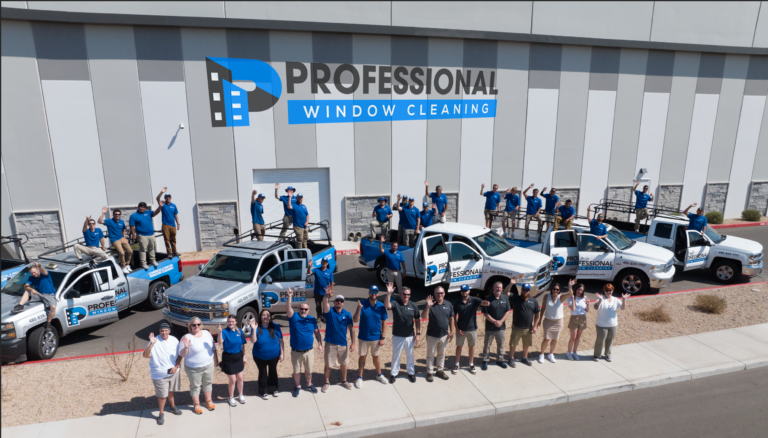Have you ever wondered how virtual reality technology is revolutionizing the way high rise window cleaners prepare for their challenging tasks?
We will explore the concept of virtual reality training, how it works, its benefits, and how it can specifically enhance high rise window cleaning preparation.
Virtual reality training provides a safe and realistic training environment, increases confidence, and reduces fear, shaping the future of this industry.
Join us as we delve into the potential risks and future possibilities of this cutting-edge technology.
What is Virtual Reality Training?
Virtual Reality Training is a cutting-edge method that leverages technology to provide immersive and interactive simulations for skills development and training purposes. It offers a glimpse into the future of training techniques by creating realistic virtual environments that mimic real-world scenarios.
With Virtual Reality Training, individuals can engage in hands-on experiences that closely resemble situations they may encounter in their actual work environments. This innovative approach allows users to practice and refine their skills in a safe and controlled setting, ultimately leading to increased proficiency and confidence.
By immersing participants in lifelike scenarios, Virtual Reality Training fosters a deeper level of understanding and retention compared to traditional training methods. This technology is proving to be invaluable in sectors where high-risk situations are common, such as medical, aviation, and military training, by providing a risk-free space to learn and make mistakes.
How Does Virtual Reality Training Work?
Virtual Reality Training functions by utilizing advanced technology to create simulated training environments that engage users in interactive experiences. It enables trainees to develop cognitive and motor skills through hands-on experiences within a virtual setting.
This cutting-edge technology leverages devices like VR headsets to immerse users in realistic scenarios, providing a highly engaging learning environment. Through simulated tasks and challenges, individuals can actively participate and practice real-world skills in a safe and controlled space. This interactive nature fosters a deeper level of engagement, allowing trainees to learn by doing rather than passively observing. As users navigate through virtual simulations, they can refine their decision-making abilities, spatial awareness, and motor coordination in a dynamic and engaging manner.
What Are the Benefits of Virtual Reality Training?
Virtual Reality Training offers numerous benefits, including innovative training methods that enhance efficiency through realistic scenarios, immersive learning experiences, equipment familiarization, hazard recognition, and engaging practice sessions. It boosts trainees’ awareness levels by immersing them in simulated environments.
This cutting-edge technology enables trainees to interact with virtual environments, promoting experiential learning and muscle memory development in a risk-free setting. By replicating real-world situations, VR training facilitates skills transfer and retention, leading to more competent and confident employees. It reduces training costs associated with traditional methods, such as travel expenses and equipment maintenance.
The interactive nature of VR also fosters better engagement and motivation among learners, resulting in higher training effectiveness and job performance.
Safe and Realistic Environment
Virtual Reality Training provides a safe yet realistic environment for trainees to practice high-risk tasks, ensuring effective risk management. It allows for the implementation of safety protocols and heightens trainees’ awareness of potential hazards.
By immersing trainees in simulated scenarios that closely mimic real-life situations, Virtual Reality Training helps individuals learn how to react to emergencies and hazardous conditions with a sense of urgency and accuracy. Trainees can make mistakes and learn from them without facing real-world consequences, allowing for a safe space to hone their skills. Not only does this method improve performance, but it also instills a deep understanding of safety procedures and protocols, ultimately leading to a more prepared and safety-conscious workforce.
Cost-effective
Virtual Reality Training proves to be a cost-effective solution compared to traditional training methods, offering efficient training delivery through realistic scenarios, the implementation of safety protocols, and the provision of highly effective training modules.
The affordability of Virtual Reality Training makes it an attractive option for various industries seeking to enhance their employees’ skills. By immersing trainees in interactive and practical simulations, VR training ensures a higher retention rate and quicker skill acquisition. This innovative approach not only minimizes costs associated with traditional training venues and materials but also significantly reduces the risks involved in hands-on training scenarios. With its ability to replicate real-world experiences in a safe and controlled environment, Virtual Reality Training guarantees a comprehensive and secure learning environment for trainees.
Time-efficient
Virtual Reality Training stands out for its time-efficient nature, allowing trainees to engage in real-world scenarios and practice sessions that lead to significant performance improvement in a shorter duration compared to conventional training methods.
This efficiency stems from the immersive nature of virtual reality environments, which provide a realistic and engaging platform for trainees to hone their skills effectively. By simulating real-world scenarios, individuals can make decisions, practice tasks, and receive feedback in a controlled yet lifelike setting. This targeted approach not only accelerates the learning process but also enhances retention and application of newly acquired knowledge. As a result, VR training proves to be a highly effective tool for skill development across various industries, minimizing time investments while maximizing learning outcomes.
Customizable Training Programs
Virtual Reality Training offers the flexibility of customizable training programs tailored to specific needs, incorporating real-world scenarios, innovative training methods, and aligning with industry standards to ensure comprehensive skill development.
By tailoring training programs to individual requirements, VR Training can address varied learning styles and preferences, making the experience more engaging and effective. Customization allows for the simulation of job-specific tasks, enhancing practical skills in a safe environment. This personalized approach maximizes learning outcomes, boosts retention rates, and ensures that trainees are well-equipped to meet the challenges of their industry.
Compliance with industry standards ensures that training content remains up-to-date and relevant, preparing individuals for real-world scenarios they may encounter in their roles.
How Can Virtual Reality Training Improve High Rise Window Cleaning Preparation?
Virtual Reality Training plays a crucial role in enhancing high rise window cleaning preparation by providing opportunities for equipment familiarization, hazard recognition, engaging practice sessions, and confidence-building exercises tailored to the unique challenges of high-altitude work.
By simulating realistic high-rise cleaning scenarios, VR training allows workers to navigate through different cleaning equipment virtually, identifying the correct tools and techniques required for efficient cleaning. It helps them recognize potential hazards that may arise in such challenging environments, enabling them to proactively address safety concerns. Through interactive practice sessions within the virtual realm, workers can refine their skills and build the necessary confidence to perform tasks at great heights effectively and securely.
Familiarization with Equipment and Techniques
Virtual Reality Training facilitates the familiarization of workers with advanced techniques, cleaning procedures, and proper equipment handling in the context of high rise window cleaning, ensuring thorough preparation for challenging tasks.
By immersing employees in realistic simulations, VR training allows them to gain practical experience in handling specialized equipment such as high-rise window cleaning tools. This interactive approach enhances their understanding of complex cleaning procedures and safety protocols, promoting a safe working environment.
VR simulations can replicate high-altitude work settings, enabling workers to acclimatize and practice critical skills in a controlled environment before facing real-life challenges. Virtual reality training plays a crucial role in boosting workers’ confidence and competence in high-risk tasks.
Practice in Different Scenarios and Environments
Virtual Reality Training allows workers to practice in diverse scenarios and environments, including challenging cleaning tasks, building maintenance simulations, and hazardous worksite scenarios, preparing them comprehensively for high rise window cleaning.
Through VR training, individuals can immerse themselves in realistic, interactive simulations where they can hone their cleaning techniques and learn how to tackle specific challenges they may encounter on the job. By virtually experiencing various maintenance tasks, such as window cleaning on tall buildings, workers can familiarize themselves with the equipment, safety protocols, and potential risks involved. This technology not only enhances skill proficiency but also fosters a deeper understanding of the importance of adhering to safety measures in high-rise settings.
Develops Muscle Memory
Virtual Reality Training aids in the development of muscle memory through repeated practice sessions and hands-on experience with advanced cleaning techniques, enabling workers to perform tasks efficiently and effectively in high-altitude work settings.
This method of training is particularly beneficial for high-rise window cleaning, where precision and safety are paramount. By immersing individuals in virtual scenarios that simulate real-world challenges, VR technology helps them internalize complex movements and sequences.
As individuals practice these tasks in the virtual environment repeatedly, their muscle memory is reinforced, resulting in more automatic and accurate execution of maneuvers when faced with similar situations in actual high-rise buildings. This muscle memory development ultimately leads to increased proficiency, reduced errors, and enhanced safety measures in the field.
Increases Confidence and Reduces Fear
Virtual Reality Training boosts workers’ confidence by reducing fear associated with high-altitude work through immersive simulations that emphasize hazard recognition, ultimately preparing them mentally and emotionally for the challenges of window cleaning at height.
As workers engage with Virtual Reality Training, they are placed in realistic high-altitude scenarios that mimic the challenges they may face in their actual work environment. By experiencing these situations in a controlled and safe virtual setting, individuals can gradually acclimatize to the heights, helping them overcome any phobias or anxieties they may have.
This exposure therapy approach has been proven to be highly effective in desensitizing workers to fears related to working at heights. The interactive nature of VR training allows workers to practice hazard recognition skills in a hands-on manner, further enhancing their confidence and decision-making abilities.
What Are the Potential Risks of Using Virtual Reality Training?
While Virtual Reality Training offers numerous benefits, potential risks include inadequate risk assessment, lack of preparation for real worksite hazards, and the need to ensure high-altitude safety measures are effectively integrated into the training programs.
Individuals engaging in Virtual Reality Training may face additional risks such as simulation sickness, visual discomfort, and reduced situational awareness leading to safety hazards. Without proper risk assessment, users could be exposed to scenarios that are not representative of actual work environments, potentially leading to inadequate skills development and increased workplace accidents.
It is essential for organizations to conduct thorough risk assessments and create training modules that prepare participants for real worksite hazards, including those related to working at heights. Integrating high-altitude safety measures into VR training protocols can help instill safe practices and prevent accidents when working in elevated environments.
What Are the Future Possibilities of Virtual Reality Training in High Rise Window Cleaning?
The future of Virtual Reality Training in high-rise window cleaning holds exciting prospects, including innovative integration with artificial intelligence for enhanced training experiences, real-time feedback mechanisms, and the potential for remote training and collaboration to revolutionize the industry.
Imagine a world where high-rise window cleaners can immerse themselves in simulated scenarios that replicate challenging real-life situations, allowing them to practice their skills in a safe and controlled environment. By incorporating artificial intelligence into VR training programs, cleaners could receive personalized coaching based on their performance, helping them improve more effectively. Real-time feedback mechanisms such as instant performance evaluations could offer immediate insights into areas for development, fostering continuous learning and growth.
The ability to conduct remote training sessions and collaborate with experts from anywhere in the world could open up new possibilities for the cleaning industry, making training more accessible and efficient.
Integration with Artificial Intelligence
The integration of Virtual Reality Training with artificial intelligence promises to revolutionize high rise window cleaning by offering advanced techniques, leveraging industry expertise, and providing personalized training experiences tailored to individual worker needs.
This cutting-edge technology allows workers to immerse themselves in realistic simulated environments, practicing complex maneuvers and procedures in a safe virtual space before applying them in real-world settings. In addition, AI algorithms can analyze performance data and provide instant feedback to help workers improve their skills effectively. By combining VR Training with AI, the window cleaning industry can enhance efficiency, safety, and precision, ultimately setting new standards for training and professional development in this specialized field.
Real-time Feedback and Assessment
Real-time feedback and assessment mechanisms in Virtual Reality Training enable precise skill evaluation, tracking of performance metrics, and immediate corrective measures, enhancing the effectiveness of training programs for high rise window cleaning.
This innovative approach provides trainees with a dynamic learning experience, allowing them to receive instant feedback on their performance as they navigate virtual scenarios simulating real-life challenges faced when cleaning high rise windows. Through this interactive training method, individuals can identify areas for improvement, understand their strengths, and make adjustments in real-time to hone their skills.
The ability to track performance metrics allows trainers to measure progress objectively, analyze trends in performance, and tailor coaching strategies to address specific skill gaps. By leveraging real-time feedback and assessment in Virtual Reality Training, organizations can optimize the training process, ensuring that high rise window cleaning professionals are equipped with the necessary expertise and proficiency to excel in their roles.
Remote Training and Collaboration
The adoption of remote training and collaboration through Virtual Reality platforms offers flexibility, compliance with industry regulations, and efficient training delivery, paving the way for a new era of high-level training in high rise window cleaning.
One of the key advantages of utilizing Virtual Reality platforms for remote training is the ability to provide flexible learning opportunities that can be accessed from any location at any time. This flexibility allows for enhanced convenience for both trainers and trainees, eliminating the constraints of physical presence.
By incorporating VR technology, businesses in the cleaning industry can ensure compliance with safety regulations by simulating real-life scenarios in a controlled virtual environment. This not only enhances the effectiveness of training but also reduces the risks associated with practical on-site training.
The immersive nature of VR training ensures that employees receive hands-on experience without the need for extensive physical resources, making it a cost-effective and efficient solution for high-level training in the cleaning sector.
Frequently Asked Questions
What is virtual reality training and how does it relate to high rise window cleaning prep?
Virtual reality training is a cutting-edge technology that allows users to experience a highly realistic and immersive simulation. It is used to train individuals for various tasks and jobs, including high rise window cleaning prep. This training method uses a combination of specialized equipment and software to create a virtual environment that closely mimics real-life scenarios.
What are the benefits of using virtual reality training for high rise window cleaning prep?
One of the main benefits of virtual reality training is its ability to provide a safe and controlled environment for learning. This is especially important for high rise window cleaning prep, where the risk of accidents and injuries is high. Virtual reality training also allows for repetitive practice and can be customized to fit the specific needs of the trainee.
How does virtual reality training improve the efficiency of high rise window cleaning prep?
By using virtual reality training, individuals can practice and perfect their skills without actually being on a high rise building. This eliminates the need for expensive equipment, travel, and on-site supervision. It also allows for quick and effective training, as individuals can easily repeat certain tasks until they are confident and proficient.
Can virtual reality training be used for all aspects of high rise window cleaning prep?
Yes, virtual reality training can be used for a wide range of tasks involved in high rise window cleaning prep, including equipment handling, safety protocols, and cleaning techniques. It can also simulate different weather conditions and scenarios, providing a comprehensive training experience for individuals.
What are the limitations of virtual reality training for high rise window cleaning prep?
Virtual reality training is a highly effective tool, but it does have some limitations. It requires specialized equipment and software, which can be costly. It also cannot fully replace hands-on experience and may not be suitable for all learning styles. As such, it is best used in combination with traditional training methods.
Is virtual reality training the future of high rise window cleaning prep?
Many experts believe that virtual reality training will play a significant role in the future of high rise window cleaning prep. With its ability to provide a safe, efficient, and customizable training experience, it is poised to become an integral part of the industry. As technology continues to advance, virtual reality training will only become more sophisticated and widely used.




